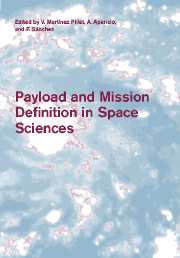Book contents
- Frontmatter
- Contents
- Preface
- Acknowledgements
- 1 The life cycle of an ESA science mission and how to get involved
- 2 Design issues for space science missions
- 3 Instrumentation in X-ray Astronomy
- 4 EUV and UV imaging and spectroscopy from space
- 5 The luminosity oscillations imager, a space instrument: from design to science
- 6 Hipparcos and Gaia: the development of space astrometry in Europe
- 7 Space Physics Instrumentation and Missions
- 8 Planetary observations and landers
1 - The life cycle of an ESA science mission and how to get involved
Published online by Cambridge University Press: 19 October 2009
- Frontmatter
- Contents
- Preface
- Acknowledgements
- 1 The life cycle of an ESA science mission and how to get involved
- 2 Design issues for space science missions
- 3 Instrumentation in X-ray Astronomy
- 4 EUV and UV imaging and spectroscopy from space
- 5 The luminosity oscillations imager, a space instrument: from design to science
- 6 Hipparcos and Gaia: the development of space astrometry in Europe
- 7 Space Physics Instrumentation and Missions
- 8 Planetary observations and landers
Summary
When I gave this talk in the Canary Islands Winter School of 2003, it was obvious that the interest of the audience was about how to make a successful proposal rather than finding out about the developing phases of a space mission. Unfortunately, I do not know how to make a 100% successful proposal. Success depends on a combination of bright ideas, creativity, timely response to the needs of a large scientific community, adequate system knowledge and, certainly, a bit of good luck. This presentation aims to make young scientists acquainted with the phases and challenges encountered in new space science missions. For that purpose these notes are organized in two sections. The first one establishes the phases of a mission, that is the process of carrying through a generic science project, while the second deals with the actual role of scientists in the whole process. Other talks in the Winter School focused in the science and the experiments that might be done, on how we can increase our knowledge of the Universe by means of space technologies. Here, we try to help making these, as well as other new ideas, real space science experiments.
- Type
- Chapter
- Information
- Payload and Mission Definition in Space Sciences , pp. 1 - 16Publisher: Cambridge University PressPrint publication year: 2005



